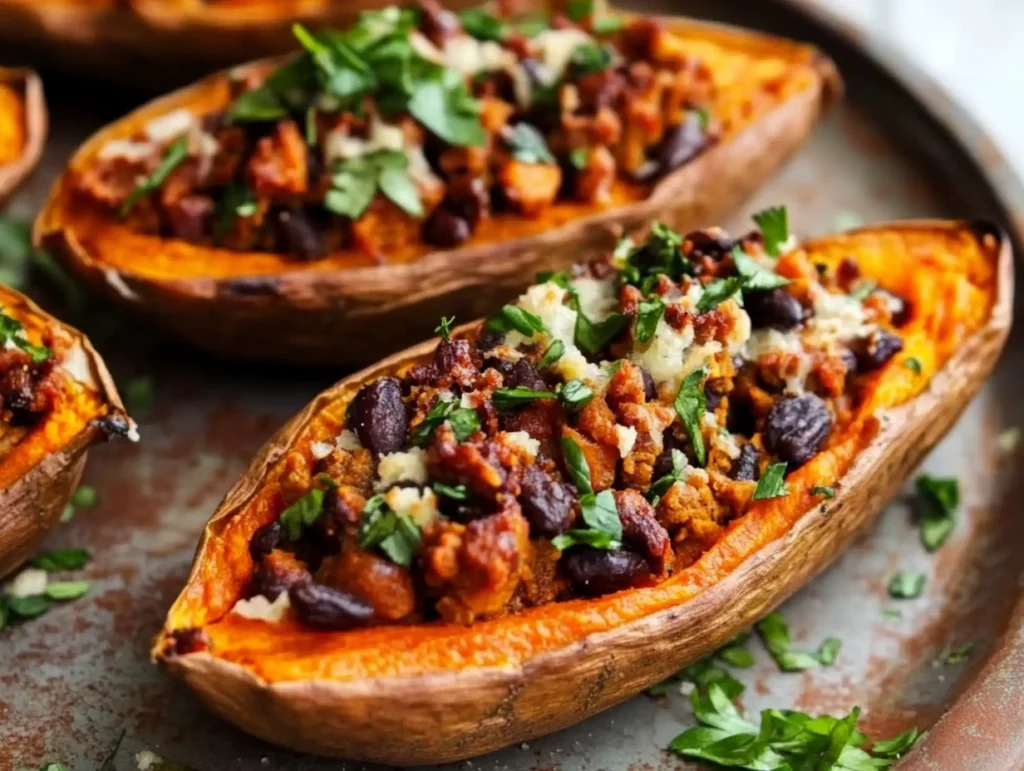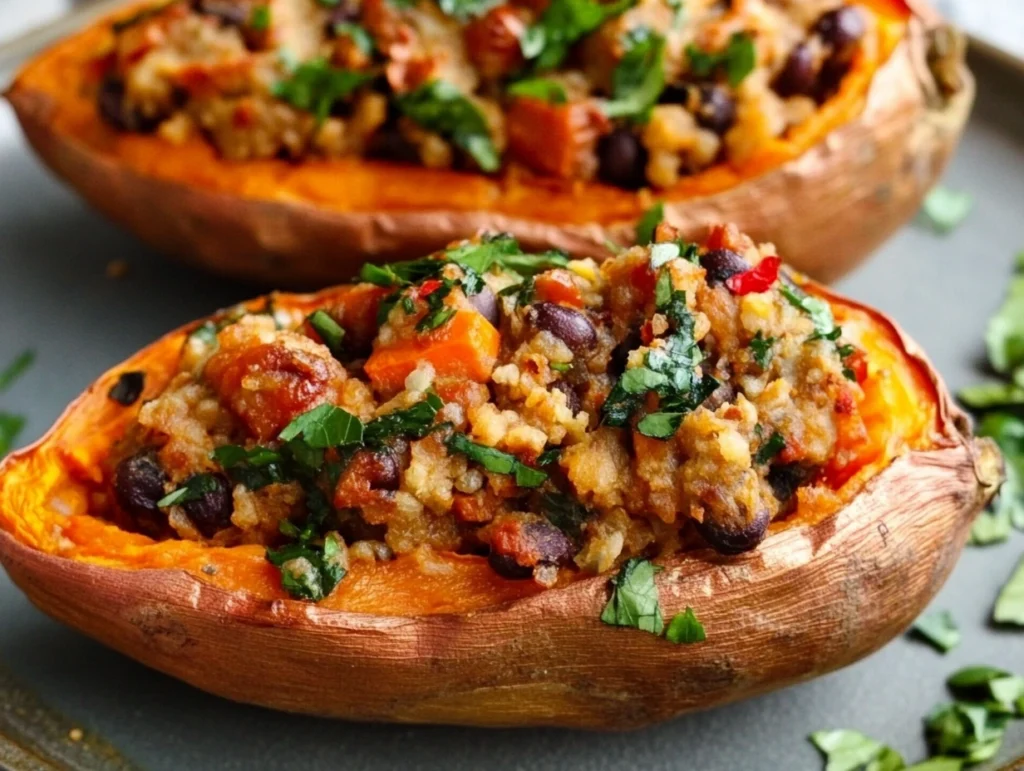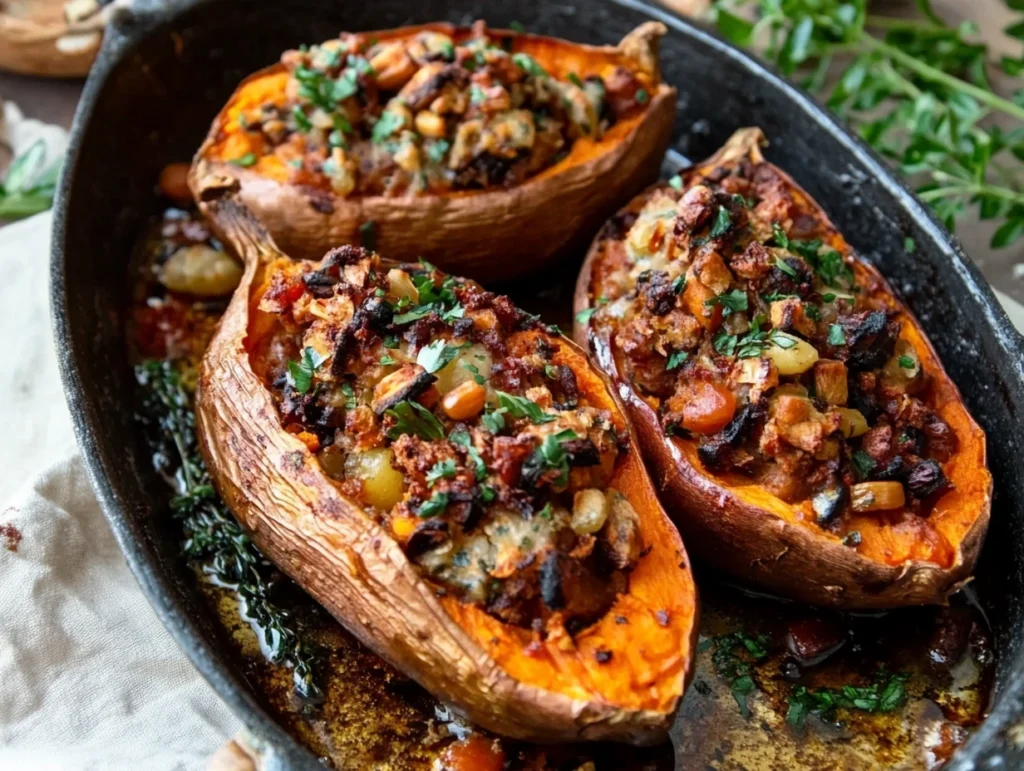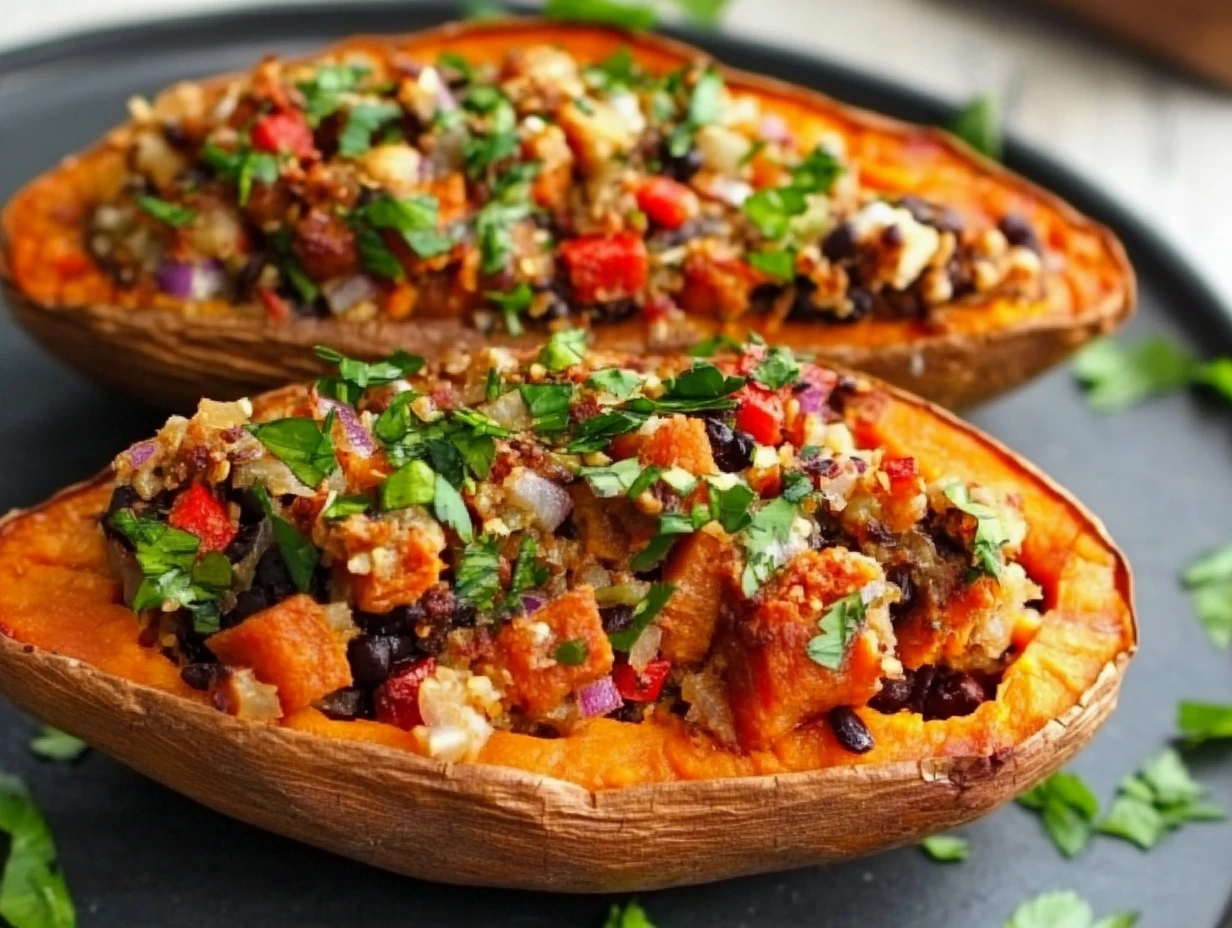Sweet potatoes have taken the culinary world by storm, and for good reason! These vibrant, nutrient-packed root vegetables serve as a perfect base for a variety of delicious and satisfying meals. Their natural sweetness pairs beautifully with both savory and sweet toppings, making them an incredibly versatile choice for home cooks and food lovers alike.
Not only are stuffed sweet potatoes easy to prepare, but they also offer an abundance of health benefits. Packed with essential vitamins, fiber, and antioxidants, they make a fantastic addition to a balanced diet—especially for those following a plant-based lifestyle. Whether you’re looking for a quick weeknight dinner, a meal-prep-friendly option, or a dish that can impress guests, these vegan stuffed sweet potato recipes are sure to satisfy.
Table of Contents
Why Sweet Potatoes Are a Superfood?
Sweet potatoes aren’t just delicious—they’re also one of the most nutritious foods you can eat. Here’s why they’ve earned their superfood status:
1. Rich in Essential Nutrients
Sweet potatoes are loaded with vitamins and minerals that support overall health. They are particularly high in:
- Vitamin A (Beta-Carotene): Supports eye health, immune function, and glowing skin.
- Vitamin C: A powerful antioxidant that helps boost immunity and promote collagen production.
- Potassium: A key electrolyte that helps regulate blood pressure and muscle function.
2. High in Fiber for Gut Health
Sweet potatoes are a great source of dietary fiber, which plays a crucial role in digestion and gut health. Fiber helps:
- Promote a healthy gut microbiome by feeding beneficial bacteria.
- Regulate blood sugar levels, preventing energy crashes.
- Keep you full longer, aiding in weight management.
3. Packed with Antioxidants
The vibrant orange and purple varieties of sweet potatoes contain powerful antioxidants that help fight inflammation and reduce the risk of chronic diseases like heart disease and cancer.
4. Naturally Gluten-Free and Low on the Glycemic Index
Unlike refined carbs, sweet potatoes provide slow-digesting, complex carbohydrates that offer steady energy without causing rapid blood sugar spikes.
With their impressive nutritional profile, sweet potatoes are an excellent choice for fueling your body and nourishing your health.
How to Choose the Best Sweet Potatoes?
Selecting the right sweet potatoes is key to making the most delicious stuffed creations. Follow these simple tips to ensure you pick the best ones:
1. Look for Firm, Smooth Skin
Choose sweet potatoes with smooth, unblemished skin free from cuts, bruises, or soft spots. Wrinkles or sprouting can indicate that the potato is past its prime.
2. Pick the Right Size
For stuffing, medium-sized sweet potatoes (about 5-6 inches long) work best. They cook evenly and have the perfect balance of skin-to-flesh ratio for stuffing.
3. Consider the Variety
There are different types of sweet potatoes, and each brings unique flavors and textures:
- Orange-Fleshed (Beauregard, Garnet, Jewel): Naturally sweet and creamy, ideal for both savory and sweet fillings.
- Purple Sweet Potatoes: Rich in antioxidants, slightly denser, and less sweet. Great for vibrant, nutrient-dense meals.
- White Sweet Potatoes: Milder in flavor and slightly drier, making them a great choice for savory dishes.
4. Store Them Properly
Keep sweet potatoes in a cool, dry, and dark place (not in the fridge). Proper storage helps maintain their texture and flavor.

Storage and Preparation Tips
To get the best flavor and nutrition out of your sweet potatoes, proper storage and preparation are key. Here’s how to ensure they stay fresh and retain their nutrients:
1. Proper Storage
- Keep them in a cool, dark, and dry place – Avoid refrigerating raw sweet potatoes, as the cold temperature can alter their texture and taste.
- Store in a ventilated area – Use a basket or paper bag instead of a sealed plastic bag to prevent moisture buildup, which can cause spoilage.
- Use them within a few weeks – Fresh sweet potatoes can last 3-5 weeks when stored correctly.
2. Washing & Cleaning
- Rinse under cold water – Remove any dirt by scrubbing gently with a vegetable brush.
- Don’t peel before cooking – The skin helps lock in nutrients and moisture during cooking. If peeling is necessary, do it after cooking for easier removal.
3. Preparation Techniques
- Pierce the skin before cooking – This prevents them from bursting while baking or microwaving.
- Cut evenly for roasting – For quicker, even cooking, slice them into similar-sized pieces if roasting instead of baking whole.
How to Cook Sweet Potatoes for Stuffing?
The cooking method you choose will impact the texture and flavor of your stuffed sweet potatoes. Here are the best ways to cook them for stuffing:
1. Baking (Best for a Soft, Creamy Texture)
- Preheat oven to 400°F (200°C).
- Place whole, unpeeled sweet potatoes on a baking sheet.
- Pierce the skin a few times with a fork.
- Bake for 45-60 minutes, until fork-tender.
2. Roasting (For a Slightly Crispy Skin)
- Preheat oven to 425°F (220°C).
- Slice sweet potatoes in half lengthwise, rub with olive oil, and season as desired.
- Place cut-side down on a baking sheet.
- Roast for 30-40 minutes until the edges caramelize.
3. Microwaving (For a Quick Meal)
- Pierce the skin with a fork several times.
- Microwave on high for 5-7 minutes, flipping halfway through.
- Let rest for a minute before cutting open.
Top 5 Vegan Stuffed Sweet Potato Recipes
Now that your sweet potatoes are perfectly cooked, let’s explore ten mouthwatering vegan stuffing ideas!
1. Mediterranean Chickpea & Hummus Delight
A fresh, protein-packed dish bursting with Mediterranean flavors.
Ingredients:
- 1 cooked sweet potato
- ½ cup chickpeas (cooked or canned, drained)
- 2 tbsp hummus
- 4-5 sliced olives
- 1 tbsp tahini dressing
- Fresh parsley and lemon juice
Instructions:
- Mash the hummus and chickpeas together.
- Stuff the sweet potato with the mixture.
- Top with olives, tahini, parsley, and a squeeze of lemon.
2. Spicy Black Bean & Avocado Fiesta
A Tex-Mex-inspired creation with a spicy kick.
Ingredients:
- 1 cooked sweet potato
- ½ cup black beans (cooked or canned, drained)
- ¼ avocado, diced
- 1 tbsp salsa or hot sauce
- 1 tbsp chopped cilantro
- Squeeze of lime juice
Instructions:
- Mash some of the black beans and mix with salsa.
- Stuff the sweet potato and top with avocado, cilantro, and lime.
3. Creamy Mushroom & Spinach Comfort
A savory, comforting meal with rich, umami flavors.
Ingredients:
- 1 cooked sweet potato
- ½ cup sautéed mushrooms
- ½ cup spinach, wilted
- 2 tbsp cashew cream (or any dairy-free cream)
- Salt and pepper to taste
Instructions:
- Sauté mushrooms and spinach together.
- Stuff the sweet potato and drizzle with cashew cream.
4. Thai-Inspired Peanut & Tofu Infusion
A sweet and spicy twist packed with plant-based protein.
Ingredients:
- 1 cooked sweet potato
- ½ cup cubed tofu (pan-fried or baked)
- 2 tbsp peanut sauce
- 1 tbsp crushed peanuts
- Fresh cilantro and red pepper flakes
Instructions:
- Toss tofu in peanut sauce.
- Stuff the sweet potato and garnish with peanuts and cilantro.
5. Classic Quinoa & Roasted Veggie Bowl
A balanced meal full of protein and fiber.
Ingredients:
- 1 cooked sweet potato
- ½ cup cooked quinoa
- ¼ cup roasted zucchini and bell peppers
- 1 tbsp balsamic glaze
Instructions:
- Mix quinoa with roasted vegetables.
- Stuff the sweet potato and drizzle with balsamic glaze.
Health Benefits of a Vegan Diet
A plant-based diet isn’t just good for the planet—it also comes with a wealth of health benefits. By focusing on whole, nutrient-dense foods like vegetables, legumes, nuts, and seeds, you can support your overall well-being in several key ways.
1. Improved Digestion and Gut Health
Vegan diets are naturally high in fiber, which is essential for a healthy digestive system. Fiber helps:
- Promote regular bowel movements and prevent constipation.
- Feed beneficial gut bacteria, improving microbiome diversity.
- Reduce bloating and digestive discomfort by encouraging smoother digestion.
Sweet potatoes, in particular, are a fantastic prebiotic food, meaning they nourish the good bacteria in your gut and enhance overall gut health.
2. Supports Heart Health
A diet rich in whole plant foods has been shown to lower the risk of heart disease. The benefits include:
- Lower cholesterol levels: Plant-based foods are free from cholesterol and saturated fats found in animal products.
- Reduced blood pressure: Nutrients like potassium (abundant in sweet potatoes) help regulate blood pressure.
- Anti-inflammatory effects: Antioxidants found in colorful plant foods fight inflammation, a key contributor to heart disease.
3. Boosted Energy Levels
Plant-based diets provide steady, long-lasting energy without the crashes associated with processed foods. Sweet potatoes are a great example, as they offer:
- Complex carbohydrates for sustained energy.
- B vitamins to support metabolism.
- Iron and magnesium, which help reduce fatigue and improve muscle function.

Meal Prepping & Storage Tips
Stuffed sweet potatoes are a meal-prep dream—they’re easy to make in advance, store well, and reheat beautifully. Here’s how to prep and store them for ultimate convenience:
1. Prepping Ahead of Time
- Batch cook sweet potatoes – Bake or roast several at once and store them in the fridge for quick meals throughout the week.
- Prepare fillings separately – Store stuffing ingredients like roasted chickpeas, sautéed veggies, or dressings in airtight containers.
- Assemble just before eating – This keeps flavors fresh and textures perfect.
2. Best Storage Methods
- Refrigeration: Store cooked sweet potatoes and fillings separately in airtight containers for up to 5 days.
- Freezing: For longer storage, wrap whole cooked sweet potatoes in foil and place them in freezer-safe bags for up to 3 months. Let them thaw overnight in the fridge before reheating.
3. How to Reheat
- Oven: Bake at 350°F (175°C) for 10-15 minutes to restore crispiness.
- Microwave: Heat in 30-second intervals until warmed through.
- Stovetop: Sauté fillings separately to refresh flavors before adding them to the sweet potato.
Common Mistakes to Avoid When Making Stuffed Sweet Potatoes
Even the most seasoned cooks can run into pitfalls when making stuffed sweet potatoes. Here are the top mistakes to watch out for:
1. Overcooking or Undercooking the Sweet Potatoes
- Overcooking can make sweet potatoes too mushy, causing them to fall apart.
- Undercooking leads to a tough, fibrous texture.
Solution: Bake at 400°F (200°C) for 45-60 minutes until a fork easily pierces the flesh.
2. Not Seasoning Properly
- Sweet potatoes have a naturally sweet flavor, but they still need seasoning to enhance their taste.
Solution: Add salt, pepper, and spices like cumin, paprika, or cinnamon to balance flavors.
3. Skipping Texture Variety
- A soft filling inside a soft potato can feel one-dimensional.
Solution: Mix crunchy toppings (nuts, seeds, crispy chickpeas) with creamy elements (hummus, avocado) for balance.
4. Overloading Fillings
- While it’s tempting to stuff sweet potatoes with everything, too many ingredients can make them difficult to eat.
Solution: Keep it simple—stick to 3-4 key ingredients per recipe for the best flavor combination.

FAQs: Everything You Need to Know
Got questions about making the perfect vegan stuffed sweet potatoes? You’re not alone! Here are answers to some of the most frequently asked questions to help you create delicious, nutritious, and hassle-free meals.
Can I Make These Recipes Gluten-Free?
Absolutely! Sweet potatoes themselves are naturally gluten-free, but some toppings and seasonings may contain gluten. Here’s how to keep your stuffed sweet potatoes safe for a gluten-free diet:
Choose gluten-free grains – Swap out couscous for quinoa, rice, or millet.
Use tamari instead of soy sauce – Regular soy sauce contains gluten, but tamari is a great alternative.
Check store-bought sauces and dressings – Some BBQ sauces, balsamic glazes, and marinades contain gluten, so always read labels.
Use gluten-free breadcrumbs or nuts for crunch – Instead of regular breadcrumbs, try crushed almonds, walnuts, or pumpkin seeds.
What Are the Best Protein Sources for Vegan Stuffing?
To make your stuffed sweet potatoes a complete meal, it’s important to include plant-based proteins. Here are some of the best options:
Legumes – Chickpeas, black beans, white beans, and lentils (7-15g protein per cup)
Tofu & Tempeh – Great for Asian-inspired or savory recipes (10-20g per serving)
Quinoa – A high-protein grain that’s light and fluffy (8g per cup)
Nuts & Seeds – Almonds, walnuts, pumpkin seeds, hemp seeds, and tahini (5-10g per serving)
Nutritional Yeast – Adds a cheesy flavor and B12 boost (5g per 2 tbsp)
Dairy-Free Yogurt or Cashew Cream – Adds creaminess with extra protein
Can I Freeze Stuffed Sweet Potatoes?
Yes! Freezing is a great way to prepare meals ahead of time. Follow these steps to freeze and reheat them properly:
How to Freeze:
- Let them cool completely before freezing.
- Wrap individually in plastic wrap or foil to prevent freezer burn.
- Store in an airtight container or freezer-safe bag for up to 3 months.
How to Reheat:
- Oven: Bake at 350°F (175°C) for 15-20 minutes.
- Microwave: Heat in 1-minute intervals until warmed through.
- Air Fryer: Reheat at 375°F (190°C) for 5-7 minutes for crispy skin.
Which Sweet Potato Variety Is Best?
There are several varieties of sweet potatoes, each with different flavors and textures. Here’s a quick breakdown:
Orange Sweet Potatoes (Beauregard, Jewel, Garnet) – Sweet, soft, and creamy; great for all recipes.
Purple Sweet Potatoes (Stokes, Okinawan) – Dense, slightly nutty, and packed with antioxidants.
White Sweet Potatoes (Hannah, Japanese) – Milder in flavor, firmer texture, and less sweet.
How Can I Make These Recipes Kid-Friendly?
If you’re cooking for kids, here are some simple ways to make stuffed sweet potatoes more appealing:
Reduce spice levels – Cut back on chili powder, cayenne, or hot sauces.
Incorporate fun toppings – Let kids add their own toppings like corn, avocado, or crispy chickpeas.
Make smaller portions – Use mini sweet potatoes or cut larger ones in half for easier eating.
Go for sweeter flavors – The Maple Walnut Bliss recipe with cinnamon and nuts is a kid-approved favorite.
What Sauces Pair Well with Stuffed Sweet Potatoes?
A good sauce can take your stuffed sweet potatoes to the next level! Here are some great options:
Tahini Dressing – Creamy, nutty, and perfect for Mediterranean flavors.
Buffalo Sauce – Spicy and tangy, great for a kick of heat.
Avocado Lime Crema – Cool and refreshing, perfect for Tex-Mex recipes.
Lemon Garlic Hummus – Adds protein and a zesty flavor boost.
Peanut or Almond Sauce – Great for Thai or Asian-inspired fillings.
Balsamic Glaze – A touch of sweetness for roasted veggie-stuffed potatoes.
For those looking to add a protein-packed side dish, check out this delicious Vegan Meatballs recipe, which pairs well with savory stuffed sweet potatoes. If you prefer a hearty breakfast option with a similar sweet-savory balance, this Vegan Banana Bread makes a great meal-prep companion. Additionally, for readers looking for creamy and tangy sauces to drizzle over their stuffed sweet potatoes, an Apple Dipping Sauce could be a unique and flavorful addition.
Conclusion
Vegan stuffed sweet potatoes are a nutrient-packed, versatile, and delicious meal option that can be enjoyed in countless ways. Whether you prefer savory, spicy, creamy, or sweet flavors, there’s a perfect stuffing combination for everyone. With their rich fiber content, essential vitamins, and plant-based protein, these stuffed sweet potatoes not only satisfy hunger but also support overall health and wellness.
By following the proper cooking, storage, and meal-prepping techniques, you can enjoy these wholesome meals with minimal effort. Plus, with the right protein sources, sauces, and toppings, you can customize each dish to fit your preferences and dietary needs.

